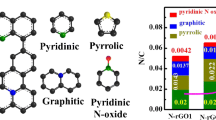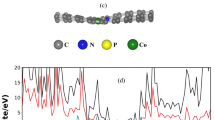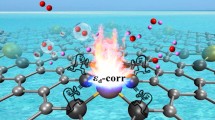Abstract
Catalytic behavior of metal-free hydroxyl group (OH) functionalized single nitrogen (N-Gra(OH)16) and triple nitrogen (N3-Gra(OH)16) doped graphene surface are investigated in the 4e− reduction pathway under oxygen reduction reaction (ORR) process. The thermodynamical parameters indicate that the reaction is highly exothermic and feasible with the N-Gra(OH)16 and N3-Gra(OH)16 as catalysts. However, N3-Gra(OH)16 exhibits better catalytic properties than N-Gra(OH)16. The chemisorption of all reactive species (*O2, *OOH, *O and *OH) via a covalent bond on the N3-Gra(OH)16 and the physisorption of the product H2O on the N3-Gra(OH)16 are essential for efficient reaction kinetics and the uninterrupted reaction cycle, respectively. Categorically, due to the presence of a large number of nitrogen atoms, the N3-Gra(OH)16 exhibits excellent catalytic activity which has resulted in lowered EHOMO–LUMO gap, concomitantly increasing the surface's reactivity. Besides the above, the barrier energies are comparable with platinum (Pt) catalysts. Our results show that the N3-Gra(OH)16 surface is the most suitable catalyst for ORR activity.



Similar content being viewed by others
Data availability
Not Applicable.
References
M. Tellez et al., Proton exchange membrane fuel cells (PEMFCs): advances and challenges. Polymers 13, 3064 (2021)
M.H. Seo et al., Theoretical insight into highly durable iron phthalocyanine derived non-precious catalysts for oxygen reduction reactions. J. Mater. Chem. A 2(46), 19707–19716 (2014)
M. Winter, R.J. Brodd, What are batteries, fuel cells, and supercapacitors? Chem. Rev. 104(10), 4245–4270 (2004)
L. Qu et al., Nitrogen-doped graphene as efficient metal-free electrocatalyst for oxygen reduction in fuel cells. ACS Nano 4(3), 1321–1326 (2010)
C. Chowdhury, A. Datta, Silicon-doped nitrogen-coordinated graphene as electrocatalyst for oxygen reduction reaction. J. Phys. Chem. C 122(48), 27233–27240 (2018)
M. Shao et al., Recent advances in electrocatalysts for oxygen reduction reaction. Chem. Rev. 116(6), 3594–3657 (2016)
D. Liu et al., Recent advances on non-precious metal porous carbon-based electrocatalysts for oxygen reduction reaction. ChemElectroChem 5(14), 1775–1785 (2018)
Y. Nie, L. Li, Z. Wei, Recent advancements in Pt and Pt-free catalysts for oxygen reduction reaction. Chem. Soc. Rev. 44(8), 2168–2201 (2015)
L.-y Feng, Y.-j Liu, J.-X. Zhao, Iron-embedded boron nitride nanosheet as a promising electrocatalyst for the oxygen reduction reaction (ORR): a density functional theory (DFT) study. J. Power Sources 287, 431–438 (2015)
Q. Wei et al., Nitrogen-doped carbon nanotube and graphene materials for oxygen reduction reactions. Catalysts 5, 1574–1602 (2015)
J. Zhang, Z. Wang, Z. Zhu, The inherent kinetic electrochemical reduction of oxygen into H2O on FeN4-carbon: a density functional theory study. J. Power Sources 255, 65–69 (2014)
J. Zhang, Z. Wang, Z. Zhu, A density functional theory study on oxygen reduction reaction on nitrogen-doped graphene. J. Mol. Model. 19(12), 5515–5521 (2013)
Y. Meng et al., Rhodium and nitrogen codoped graphene as a bifunctional electrocatalyst for the oxygen reduction reaction and CO2 reduction reaction: mechanism insights. J. Phys. Chem. C 123(9), 5176–5187 (2019)
Z. Duan, G. Wang, A first principles study of oxygen reduction reaction on a Pt(111) surface modified by a subsurface transition metal M (M = Ni Co, or Fe). Phys. Chem. Chem. Phys. 13(45), 20178–20187 (2011)
M. Kiani et al., Facile synthesis of magnesium ferrite nanoparticles supported on nitrogen and sulfur co-doped carbon black as an efficient electrocatalyst for oxygen reduction reaction. J. Nanopart. Res. 21(5), 99 (2019)
H. Tan et al., Sub-50 nm iron–nitrogen-doped hollow carbon sphere-encapsulated iron carbide nanoparticles as efficient oxygen reduction catalysts. Advanced Science 5(7), 1800120 (2018)
Z. Yang et al., Sulfur-doped graphene as an efficient metal-free cathode catalyst for oxygen reduction. ACS Nano 6, 205–211 (2011)
P. Chandran, A. Ghosh, S. Ramaprabhu, High-performance Platinum-free oxygen reduction reaction and hydrogen oxidation reaction catalyst in polymer electrolyte membrane fuel cell. Sci. Rep. 8(1), 3591 (2018)
W. Xia et al., Earth-Abundant Nanomaterials for Oxygen Reduction. Angew. Chem. Int. Ed. 55(8), 2650–2676 (2016)
F. Li et al., Atomic mechanism of electrocatalytically active Co–N complexes in graphene basal plane for oxygen reduction reaction. ACS Appl. Mater. Interfaces. 7(49), 27405–27413 (2015)
L. Dai et al., Metal-free catalysts for oxygen reduction reaction. Chem. Rev. 115(11), 4823–4892 (2015)
X. Liu, L. Dai, Carbon-based metal-free catalysts. Nat. Rev. Mater. 1(11), 16064 (2016)
T. Thiruppathiraja et al., H, OH and COOH functionalized magnesium phthalocyanine as a catalyst for oxygen reduction reaction (ORR) – A DFT study. Int. J. Hydrogen Energy 45(15), 8540–8548 (2020)
Z. Zhang et al., Systematic study of transition-metal (Fe Co, Ni, Cu) phthalocyanines as electrocatalysts for oxygen reduction and their evaluation by DFT. RSC Adv. 6(71), 67049–67056 (2016)
B. Modak, K. Srinivasu, S.K. Ghosh, Exploring metal decorated Porphyrin-like Porous Fullerene as catalyst for oxygen reduction reaction: a DFT study. Int. J. Hydrogen Energy 42(4), 2278–2287 (2017)
Y. Gao et al., Graphdiyne-supported single-atom-sized Fe catalysts for the oxygen reduction reaction: DFT predictions and experimental validations. ACS Catal. 8(11), 10364–10374 (2018)
Q. Wei et al., Nitrogen-doped carbon nanotube and graphene materials for oxygen reduction reactions. Catalysts 5(3), 1574–1602 (2015)
R. Liu et al., Nitrogen-doped graphdiyne as a metal-free catalyst for high-performance oxygen reduction reactions. Nanoscale 6(19), 11336–11343 (2014)
G. Fazio, L. Ferrighi, C. Di Valentin, Boron-doped graphene as active electrocatalyst for oxygen reduction reaction at a fuel-cell cathode. J. Catal. 318, 203–210 (2014)
X. Zou, L. Wang, B.I. Yakobson, Mechanisms of the oxygen reduction reaction on B- and/or N-doped carbon nanomaterials with curvature and edge effects. Nanoscale 10(3), 1129–1134 (2018)
T. Thiruppathiraja, A.L. Arokiyanathan, S. Lakshmipathi, Pyrrolic, pyridinic, and graphitic sumanene as metal-free catalyst for oxygen reduction reaction—a density functional theory study. Fuel Cells 21(6), 490–501 (2021)
Z. Wang et al., Nitrogen-promoted self-assembly of N-doped carbon nanotubes and their intrinsic catalysis for oxygen reduction in fuel cells. ACS Nano 5(3), 1677–1684 (2011)
S. Ratso et al., Highly active nitrogen-doped few-layer graphene/carbon nanotube composite electrocatalyst for oxygen reduction reaction in alkaline media. Carbon 73, 361–370 (2014)
D. Higgins et al., The application of graphene and its composites in oxygen reduction electrocatalysis: a perspective and review of recent progress. Energy Environ. Sci. 9(2), 357–390 (2016)
M. Reda, H.A. Hansen, T. Vegge, DFT study of stabilization effects on N-doped graphene for ORR catalysis. Catal. Today 312, 118–125 (2018)
C. Zhang et al., Synthesis of phosphorus-doped graphene and its multifunctional applications for oxygen reduction reaction and lithium ion batteries. Adv. Mater. 25(35), 4932–4937 (2013)
D.-S. Yang et al., Phosphorus-doped ordered mesoporous carbons with different lengths as efficient metal-free electrocatalysts for oxygen reduction reaction in alkaline media. J. Am. Chem. Soc. 134(39), 16127–16130 (2012)
X. Bai et al., Theoretical insights on the reaction pathways for oxygen reduction reaction on phosphorus doped graphene. Carbon 105, 214–223 (2016)
Z. Yang et al., Sulfur-doped graphene as an efficient metal-free cathode catalyst for oxygen reduction. ACS Nano 6(1), 205–211 (2012)
L.S. Panchakarla et al., Synthesis, structure, and properties of boron- and nitrogen-doped graphene. Adv. Mater. 21(46), 4726–4730 (2009)
Y. Zheng et al., Two-step boron and nitrogen doping in graphene for enhanced synergistic catalysis. Angew. Chem. Int. Ed. 52(11), 3110–3116 (2013)
S. Kattel, P. Atanassov, B. Kiefer, Density functional theory study of the oxygen reduction reaction mechanism in a BN co-doped graphene electrocatalyst. J. Mater. Chem. A 2(26), 10273–10279 (2014)
J. Liang et al., Sulfur and nitrogen dual-doped mesoporous graphene electrocatalyst for oxygen reduction with synergistically enhanced performance. Angew. Chem. Int. Ed. 51(46), 11496–11500 (2012)
Y. Su et al., Low-temperature synthesis of nitrogen/sulfur co-doped three-dimensional graphene frameworks as efficient metal-free electrocatalyst for oxygen reduction reaction. Carbon 62, 296–301 (2013)
X. Wang et al., One-pot synthesis of nitrogen and sulfur co-doped graphene as efficient metal-free electrocatalysts for the oxygen reduction reaction. Chem. Commun. 50(37), 4839–4842 (2014)
Z. Zuo et al., Synthesis and applications of graphdiyne-based metal-free catalysts. Adv. Mater. 31(13), 1803762 (2019)
C. Hu, L. Dai, Carbon-based metal-free catalysts for electrocatalysis beyond the ORR. Angew. Chem. Int. Ed. 55(39), 11736–11758 (2016)
R. Ma et al., A review of oxygen reduction mechanisms for metal-free carbon-based electrocatalysts. npj Comput. Mater. 5(1), 78 (2019)
F. An et al., Carbon-based metal-free oxygen reduction reaction electrocatalysts: past, present and future. New Carbon Mater. 37(2), 338–354 (2022)
J. Zhang, Z. Xia, L. Dai, Carbon-based electrocatalysts for advanced energy conversion and storage. Sci Adv. 1(7), e1500564 (2015)
N. Wang et al., Graphitic nitrogen is responsible for oxygen electroreduction on nitrogen-doped carbons in alkaline electrolytes: insights from activity attenuation studies and theoretical calculations. ACS Catal. 8(8), 6827–6836 (2018)
A. Ferre-Vilaplana, E. Herrero, Why nitrogen favors oxygen reduction on graphitic materials. Sustain. Energy Fuels 3(9), 2391–2398 (2019)
L. Zhang, Z. Xia, Mechanisms of oxygen reduction reaction on nitrogen-doped graphene for fuel cells. J. Phys. Chem. C 115(22), 11170–11176 (2011)
D.S. Su et al., Metal-free heterogeneous catalysis for sustainable chemistry. Chemsuschem 3(2), 169–180 (2010)
H. Wang, T. Maiyalagan, X. Wang, Review on recent progress in nitrogen-doped graphene: synthesis, characterization, and its potential applications. ACS Catal. 2(5), 781–794 (2012)
T. Thiruppathiraja, S. Lakshmipathi, N-piperidinyl substituted trioxotriangulene as an efficient catalyst for oxygen reduction reaction in fuel cell application—a DFT study. Ionics (2022). https://doi.org/10.1007/s11581-022-04860-5
L. Cao et al., Identification of single-atom active sites in carbon-based cobalt catalysts during electrocatalytic hydrogen evolution. Nat. Catal. 2(2), 134–141 (2019)
A.D. Becke, Density-functional exchange-energy approximation with correct asymptotic behavior. Phys. Rev. A 38(6), 3098–3100 (1988)
C. Lee, W. Yang, R.G. Parr, Development of the Colle-Salvetti correlation-energy formula into a functional of the electron density. Phys. Rev. B 37(2), 785–789 (1988)
Y. Zhao, D.G. Truhlar, The M06 suite of density functionals for main group thermochemistry, thermochemical kinetics, noncovalent interactions, excited states, and transition elements: two new functionals and systematic testing of four M06-class functionals and 12 other functionals. Theoret. Chem. Acc. 120(1), 215–241 (2008)
C. Riplinger et al., Natural triple excitations in local coupled cluster calculations with pair natural orbitals. J. Chem. Phys. 139(13), 134101 (2013)
F. Neese, Software update: the ORCA program system, version 40. WIREs Comput. Mol. Sci. 8(1), e1327 (2018)
M. Valiev et al., NWChem: a comprehensive and scalable open-source solution for large scale molecular simulations. Comput. Phys. Commun. 181(9), 1477–1489 (2010)
T. Lu, F. Chen, Multiwfn: a multifunctional wavefunction analyzer. J. Comput. Chem. 33(5), 580–592 (2012)
T.V. Pham et al., High areal capacitance of N-doped graphene synthesized by arc discharge. Adv. Func. Mater. 29(48), 1905511 (2019)
S. Armaković et al., Aromaticity, response, and nonlinear optical properties of sumanene modified with boron and nitrogen atoms. J. Mol. Model. 20(12), 2538 (2014)
A. Legarreta-Mendoza, N. Flores-Holguín, D. Lardizabal-Gutiérrez, A proposal based on quantum phenomena for the ORR mechanism on nitrogen-doped carbon-based electrocatalysts. Int. J. Hydrogen Energy 44(24), 12374–12380 (2019)
M. Li et al., N-doped graphene as catalysts for oxygen reduction and oxygen evolution reactions: theoretical considerations. J. Catal. 314, 66–72 (2014)
S. Sun, N. Jiang, D. Xia, Density functional theory study of the oxygen reduction reaction on metalloporphyrins and metallophthalocyanines. J. Phys. Chem. C 115(19), 9511–9517 (2011)
Y. Yang et al., A density functional study on the oxygen reduction reaction mechanism on FeN2-doped graphene. New J. Chem. 42(9), 6873–6879 (2018)
X. Sun et al., The oxygen reduction reaction mechanism on Sn doped graphene as an electrocatalyst in fuel cells: a DFT study. RSC Adv. 7, 729–734 (2017)
B. Qin et al., A density functional theory study of the oxygen reduction reaction on the (111) and (100) surfaces of cobalt(II) oxide. Prog. React. Kinet. Mech. 44(2), 122–131 (2019)
J. Zhao, Z. Chen, Carbon-doped boron nitride nanosheet: an efficient metal-free electrocatalyst for the oxygen reduction reaction. J. Phys. Chem. C 119(47), 26348–26354 (2015)
P. Zhang et al., Size effect of oxygen reduction reaction on nitrogen-doped graphene quantum dots. RSC Adv. 8, 531–536 (2018)
P. Zhang et al., Layered SiC sheets: a potential catalyst for oxygen reduction reaction. Sci. Rep. 4(1), 3821 (2014)
L. Wang et al., Potential application of novel boron-doped graphene nanoribbon as oxygen reduction reaction catalyst. J. Phys. Chem. C 120(31), 17427–17434 (2016)
X. Chen et al., Density functional theory study of the oxygen reduction reaction on a cobalt-polypyrrole composite catalyst. J. Phys. Chem. C 116(23), 12553–12558 (2012)
L. Yu et al., Oxygen reduction reaction mechanism on nitrogen-doped graphene: a density functional theory study. J. Catal. 282(1), 183–190 (2011)
A.M. Priya, L. Senthilkumar, Degradation of methyl salicylate through Cl initiated atmospheric oxidation—a theoretical study. RSC Adv. 4(45), 23464–23475 (2014)
P.S.V. Kumar, V. Raghavendra, V. Subramanian, Bader’s theory of atoms in molecules (AIM) and its applications to chemical bonding. J. Chem. Sci. 128(10), 1527–1536 (2016)
P.L.A. Popelier, R.F.W. Bader, The existence of an intramolecular C-H-O hydrogen bond in creatine and carbamoyl sarcosine. Chem. Phys. Lett. 189(6), 542–548 (1992)
U. Koch, P.L.A. Popelier, Characterization of C-H-O hydrogen bonds on the basis of the charge density. J. Phys. Chem. 99(24), 9747–9754 (1995)
A. Lincy, L. Senthilkumar, Theoretical perspective on the interaction of CO2 and H2O molecules with functionalized magnesium and scandium phthalocyanines. Theoret. Chem. Acc. 42, 3465–3472 (2018)
D.Y. Shin et al., Density functional theory–based design of a Pt-skinned PtNi catalyst for the oxygen reduction reaction in fuel cells. Appl. Surf. Sci. 565, 150518 (2021)
P. Zhang et al., Size effect of oxygen reduction reaction on nitrogen-doped graphene quantum dots. RSC Adv. 8(1), 531–536 (2018)
K. Li et al., The oxygen reduction reaction on Pt(111) and Pt(100) surfaces substituted by subsurface Cu: a theoretical perspective. J. Mater. Chem. A 3(21), 11444–11452 (2015)
X. Chen et al., A comparative DFT study of oxygen reduction reaction on mononuclear and binuclear cobalt and iron phthalocyanines. Russ. J. Phys. Chem. A 90, 2413–2417 (2016)
D. Wang et al., The graphene-supported Lanthanum oxide cluster as efficient bifunctional electrocatalyst for oxygen reaction. Mol. Catal. 535, 112879 (2023)
W.A. Saidi, Oxygen reduction electrocatalysis using N-doped graphene quantum-dots. J. Phys. Chem. Lett. 4(23), 4160–4165 (2013)
Z. Liang et al., Exploring the oxygen electrode bi-functional activity of Ni–N–C-doped graphene systems with N, C co-ordination and OH ligand effects. J. Mater. Chem. A 8(39), 20453–20462 (2020)
Z. Liang et al., Evaluating the catalytic activity of transition metal dimers for the oxygen reduction reaction. J Colloid Interface Sci 568, 54–62 (2020)
Z. Lu et al., An isolated zinc-cobalt atomic pair for highly active and durable oxygen reduction. Angew. Chemie (International ed. in English) 58(9), 2622–2626 (2019)
L. Jin et al., CdN4C0-gra as efficient trifunctional electrocatalyst for the HER, OER and ORR: a density functional theory study. Appl. Surf. Sci. 610, 155580 (2023)
D. Chanda et al., Investigation of electrocatalytic activity on a N-doped reduced graphene oxide surface for the oxygen reduction reaction in an alkaline medium. Int. J. Hydrogen Energy 43(27), 12129–12139 (2018)
Funding
Thangaraj Thiruppathiraja would like to thank the Department of Science and Technology, New Delhi, India, for providing the financial support [DST-PURSE (II) Fellowship/2020/407].
Author information
Authors and Affiliations
Corresponding author
Additional information
Publisher's Note
Springer Nature remains neutral with regard to jurisdictional claims in published maps and institutional affiliations.
Supplementary Information
Below is the link to the electronic supplementary material.
339_2023_6464_MOESM1_ESM.doc
The possible structures with nitrogen in the edge positions, Mulliken charge analysis for N-Gra(OH)16 and N3-Gra(OH)16, the HOMO and LUMO plots, the optimized structures of N-Gra(OH)16 and N3-Gra(OH)16 with adsorbate species in the initial state (IS), transition states (TS), intermediates (IM), and final state (FS) phases and their corresponding bond lengths, the relative energy profile of ORR steps, the IRC plot of ORR reactions, the adsorption site for N-Gra(OH)16 and N3-Gra(OH)16 with ORR species, thermochemical properties of the oxygen reduction reaction calculated at M06/6-31G(d,p) level of theory, the calculated electron density and Laplacian of electron density, the rate-limiting step, minimum free energy and overpotential are calculated are given in the Supplementary Information
Rights and permissions
Springer Nature or its licensor (e.g. a society or other partner) holds exclusive rights to this article under a publishing agreement with the author(s) or other rightsholder(s); author self-archiving of the accepted manuscript version of this article is solely governed by the terms of such publishing agreement and applicable law.
About this article
Cite this article
Thiruppathiraja, T., Lakshmipathi, S. Catalytic activity of OH functionalized N-doped graphene in oxygen reduction reaction for fuel cell applications: a DFT study. Appl. Phys. A 129, 218 (2023). https://doi.org/10.1007/s00339-023-06464-w
Received:
Accepted:
Published:
DOI: https://doi.org/10.1007/s00339-023-06464-w




